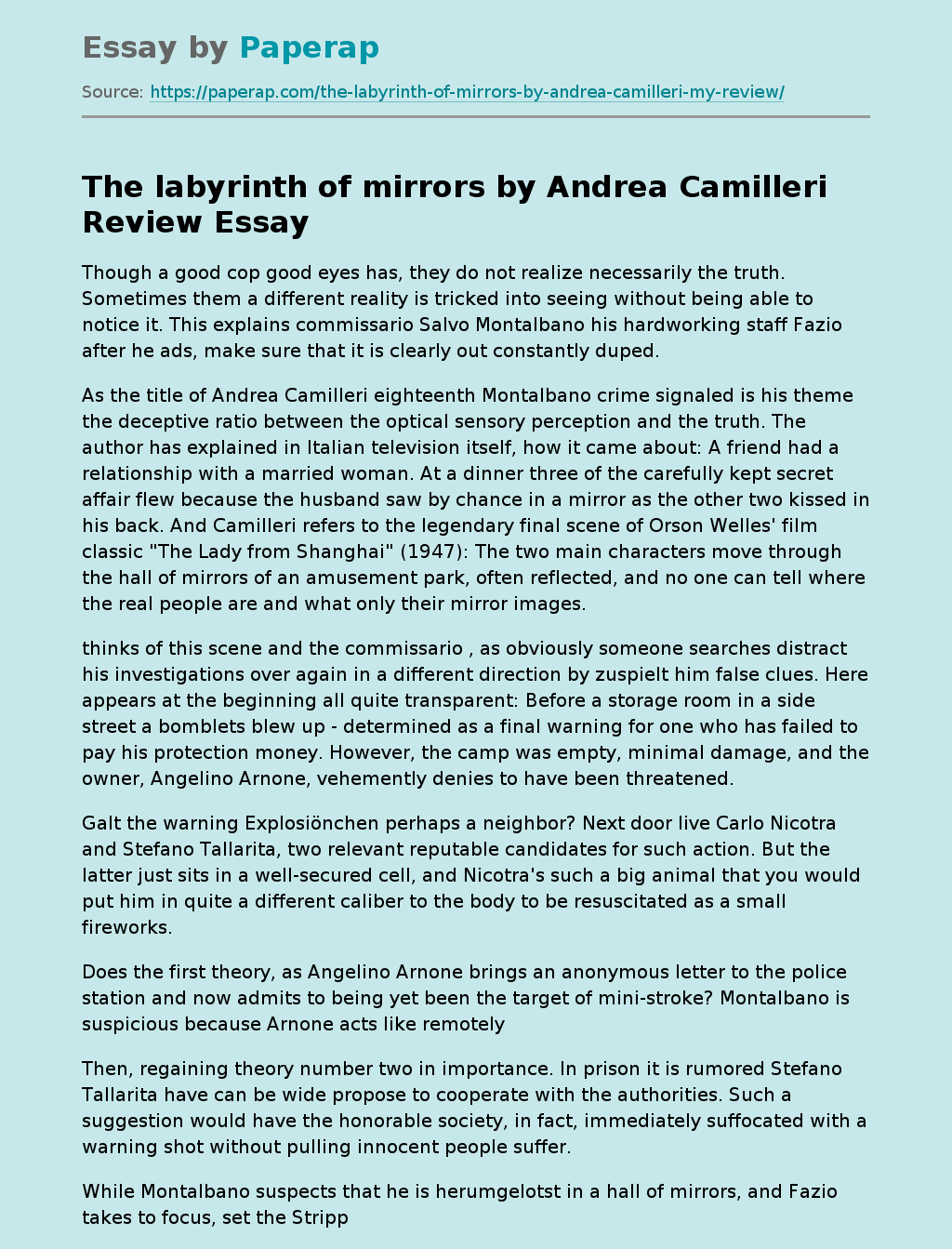“The Labyrinth of Mirrors” by Andrea Camilleri
Though a good cop good eyes has, they do not realize necessarily the truth. Sometimes them a different reality is tricked into seeing without being able to notice it. This explains commissario Salvo Montalbano his hardworking staff Fazio after he ads, make sure that it is clearly out constantly duped.
As the title of Andrea Camilleri eighteenth Montalbano crime signaled is his theme the deceptive ratio between the optical sensory perception and the truth. The author has explained in Italian television itself, how it came about: A friend had a relationship with a married woman.
At a dinner three of the carefully kept secret affair flew because the husband saw by chance in a mirror as the other two kissed in his back. And Camilleri refers to the legendary final scene of Orson Welles’ film classic “The Lady from Shanghai” (1947): The two main characters move through the hall of mirrors of an amusement park, often reflected, and no one can tell where the real people are and what only their mirror images.
thinks of this scene and the commissario , as obviously someone searches distract his investigations over again in a different direction by zuspielt him false clues. Here appears at the beginning all quite transparent: Before a storage room in a side street a bomblets blew up – determined as a final warning for one who has failed to pay his protection money. However, the camp was empty, minimal damage, and the owner, Angelino Arnone, vehemently denies to have been threatened.
Galt the warning Explosiönchen perhaps a neighbor? Next door live Carlo Nicotra and Stefano Tallarita, two relevant reputable candidates for such action.
But the latter just sits in a well-secured cell, and Nicotra’s such a big animal that you would put him in quite a different caliber to the body to be resuscitated as a small fireworks.
Does the first theory, as Angelino Arnone brings an anonymous letter to the police station and now admits to being yet been the target of mini-stroke? Montalbano is suspicious because Arnone acts like remotely. Then, regaining theory number two in importance. In prison it is rumored Stefano Tallarita have can be wide propose to cooperate with the authorities. Such a suggestion would have the honorable society, in fact, immediately suffocated with a warning shot without pulling innocent people suffer.
While Montalbano suspects that he is herumgelotst in a hall of mirrors, and Fazio takes to focus, set the Strippenzieher gradually stage a warning to the investigators themselves: They fired at his car. Montalbano notes, however nothing about it; Fazio later showed him the bullet holes on the passenger side.
Private Salvo looks more pleasant questions over. Every morning he takes his attractive new neighbor Liliana Lombardo in the city, was apparently damaged by vandals since her car (Her husband is traveling.). The confidences between the two are set up; Liliana makes Salvo beautiful eyes, goes out with him in sensational manner, gives him insight into their marriage. Truth – or only illusions
The two plot lines flowing into each other unexpectedly, as the commissario finds out that Liliana has not only flirted with him. He realizes that all the actions that have been confused him have to do with Liliana and her lover. But this is just a superficial image. And later to protect the people, to see through the Montalbano sought are no more than little pawns in a big maneuver that is staged behind the mirrors – there commissario Montalbano ventured “into dangerous realms” .
As always Rita Seuss and Walter Kögler done their best to capture in German the special atmosphere of this crime novels and typical atmosphere of play that characterizes the Montalbano series overall. An insignificant detail as evidence: The family of Liliana Lombardo domestic help is in the original Italian “Lodico” what has been called “Tell me that.” can understand. Both translators have not let it take to transfer this small effect subtly. In the German edition is the lady “Sàghino”. Still can man Camilleri’s works never appropriate translate because much of the literary character is now once coined by its idiosyncratic dialect design – an insurmountable obstacle to any transfer, even in normal.
“The Labyrinth of Mirrors” by Andrea Camilleri. (2019, Nov 18). Retrieved from https://paperap.com/the-labyrinth-of-mirrors-by-andrea-camilleri-my-review/

